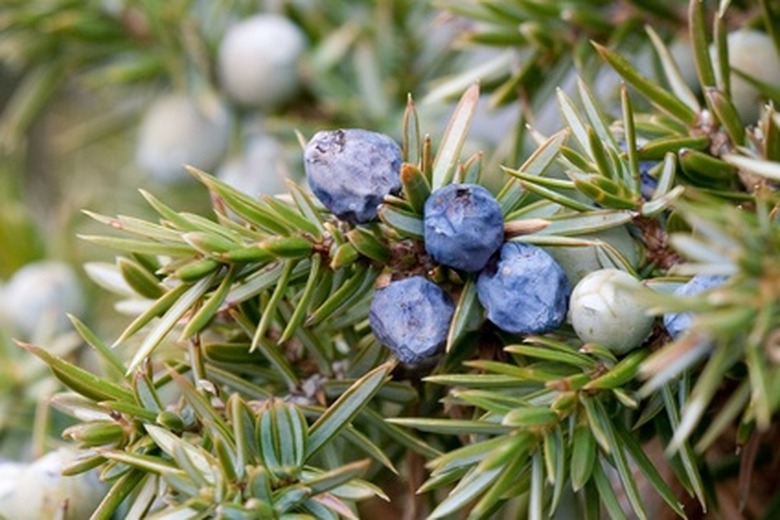Juniper Trees In Kansas
Plant juniper trees to add lush green color and ornamental interest to your landscape. Kansas lies within United States Department of Agriculture (USDA) hardiness zones 5 and 6. If you live in Kansas, select juniper trees according to appropriate zone, needle colors, cultural requirements and mature size. Various juniper tree varieties perform well in the Kansas climate.
Chinese Juniper
The Chinese juniper (Juniperus chinensis) reaches between 15 and 18 feet in height and 6 to 8 feet in width. This juniper variety tolerates various soil types, many urban pollutants and some drought conditions. Chinese junipers prefer moist, well-drained soils in fully sunny locations. This tree features a conical form, deep brown bark and brown seed cones. Female trees bear white-blue berries. Tip blight, cedar-apple rust and root rot occasionally infest these trees. Kansas gardeners often use Chinese junipers as screens and foundation plants.
- Plant juniper trees to add lush green color and ornamental interest to your landscape.
- The Chinese juniper (Juniperus chinensis) reaches between 15 and 18 feet in height and 6 to 8 feet in width.
Rocky Mountain Juniper
The Rocky Mountain juniper (Juniperus scopulorum), also called the Colorado red cedar, typically ranges from 10 to 15 feet in height and 4 to 6 feet in width. This juniper variety prefers moist, well-drained soils, but can tolerate drier soil conditions. Rocky Mountain junipers generally do not perform well in hot, humid climates. Mature trees feature pyramidal shapes, reddish-brown bark and blue-green needles that keep their color all year. These junipers sometimes suffer from phomopsis twig blight and tip dieback. Rocky Mountain junipers work well as screens or background trees.
Sargent Juniper
The Sargent juniper tree (Juniperus chinensis var. sargentii) is a low-growing variety that reaches up to 12 inches in height and 9 feet in width. This low-maintenance tree prefers well-drained soils in full sun positions, but can tolerate some shade and poor soil conditions. This juniper variety bears bluish-green needles and blue fruit. These junipers sometimes suffer from juniper blight. Kansas gardeners often use Sargent junipers as ground covers, borders and rock garden accents.
- The Rocky Mountain juniper (Juniperus scopulorum), also called the Colorado red cedar, typically ranges from 10 to 15 feet in height and 4 to 6 feet in width.
- These junipers sometimes suffer from juniper blight.
Singleseed Juniper
The singleseed juniper (Juniperus squamata) reaches 3 to 5 feet in both height and width. This type of juniper prefers moist, well-drained soils, but can tolerate sandy, dry soils. This tree features brown bark, black seed cones and pointy, needle-like leaves that emerge yellow but turn blue-green to gray-green with maturity. Cedar-apple rust, phomopsis and spider mites are occasional problems. Kansas gardeners often mass plant singleseed junipers in borders and rock gardens.
Coffin Juniper
Coffin junipers (Juniperus recurva var. coxii) earned their name because people once used the wood to make coffins. These junipers range in height from 10 to 60 feet with spreads from 5 to 20 feet. The coffin juniper grows best in moist soils that receive full sun. These trees should be planted in sites that protect them from harsh winter weather. Coffin junipers bear dark green needles, purple cones and rust-colored bark. This hardy tree has no serious potential problems. Coffin junipers typically perform well as landscape trees.
- The singleseed juniper (Juniperus squamata) reaches 3 to 5 feet in both height and width.
- The coffin juniper grows best in moist soils that receive full sun.
